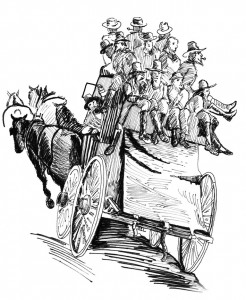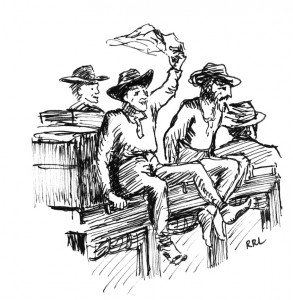 “I can remember no night of horror equal to my first night’s travel on the Overland Route,” wrote a stagecoach traveler in the 1860s. This poor man had to resort to wearing a donut-shaped air cushion around his neck to stop his skull cracking against the sides of a violently swaying coach.
“I can remember no night of horror equal to my first night’s travel on the Overland Route,” wrote a stagecoach traveler in the 1860s. This poor man had to resort to wearing a donut-shaped air cushion around his neck to stop his skull cracking against the sides of a violently swaying coach.
Another long-distance commuter wrote this, “I am here, and without any broken bones, but how my bones happen to be whole after the fearful ride up and down the Sierra Nevada mountains, I haven’t the remotest idea.” Reporter A.J. Marsh spent a good part of his trip on the outside of the stage, beside the driver. It was night and the coach was tearing along a winding road with the wheel sometimes no more than six inches from precipitous drops. Glancing nervously at the driver, Marsh was horrified to see him fast asleep. When shaken awake, the driver grumpily protested that he always slept at this point in the journey as the “horses knew every foot of the way.”
Theatrical agent Edward Hingston got a shock when travelling on the same route during the day. He glanced out the open window (no glass, lest shards cut passengers) and spotted fragments of a coach scattered at the bottom of a ravine a quarter of a mile deep. He asked the driver if anybody had died in the terrible accident. Two, replied the driver, and three severely injured survivors had recovered enough to sue the stage company. That won’t happen again, he drawled. “If we had an accident and you were badly hurt I should have to knock you on the head. Dead men don’t bring actions.”
Sir Richard Burton (the explorer, not the movie star) bluffly described his coach rolling over twice on the flatter and sandier road from Dayton to Carson City in 1861. Two of his party cracked their heads but he was more upset about a cracked bottle of cognac. “Eheu!” he lamented in mock solemn Latin “Hic jacet ampora vini.” (Alas! Here lies my bottle of wine.)
It must have been hell to ride on a stagecoach. Notices issued by stagecoach companies give a hint at what you might expect: Spit on the leeward side… Don’t smoke a strong pipe inside the coach… Never shoot on the road as the noise might frighten the horses… Don’t point out where murders have been committed, especially if there are women passengers… Don’t growl at the food received at the station… When the driver asks you to get off and walk, do so without grumbling, he won’t request it unless absolutely necessary… If the team runs away – sit still and take your chances. If you jump, nine out of ten times you will get hurt… The best seat inside a stage is at the front facing back, even if you have a tendency to sea-sickness when riding backwards.
“It is a fearful thing to be at sea in a stagecoach,” agreed Mark Twain.
And I haven’t even mentioned the very real possibility of being tortured to death by Indians or shot by highwaymen.
So did anybody ever have a pleasant journey on a stagecoach?
 There is one famous account by a certain Sam Clemens. He writes of a stagecoach journey he and his brother took across country in 1861. Their well-suspended Concord coach was so loaded with mail that they were the only passengers. This allowed them the freedom to ride in their underwear, which Sam called “undress uniform”. Sometimes they stretched out on the mail sacks. Othertimes they clambered up onto the roof of the coach and sat with their backs against luggage and their legs dangling over the side. From here they could watch the world spin by as they ate a cold lunch of ham and hard-boiled eggs. Smoking their post-prandial pipes, they admired the scenery of the Great Plains, the Rocky Mountains and Great Alkali Deserts dotted with buffalo, coyotes, jackass rabbits, desperados, Indians and Pony Express riders.
There is one famous account by a certain Sam Clemens. He writes of a stagecoach journey he and his brother took across country in 1861. Their well-suspended Concord coach was so loaded with mail that they were the only passengers. This allowed them the freedom to ride in their underwear, which Sam called “undress uniform”. Sometimes they stretched out on the mail sacks. Othertimes they clambered up onto the roof of the coach and sat with their backs against luggage and their legs dangling over the side. From here they could watch the world spin by as they ate a cold lunch of ham and hard-boiled eggs. Smoking their post-prandial pipes, they admired the scenery of the Great Plains, the Rocky Mountains and Great Alkali Deserts dotted with buffalo, coyotes, jackass rabbits, desperados, Indians and Pony Express riders.
“Nothing helps scenery like ham and eggs,” wrote Sam 10 years later. “Ham and eggs, and after these a pipe – an old, rank, delicious pipe – ham and eggs and scenery, a ‘down grade,’ a flying coach, a fragrant pipe and a contented heart – these make happiness. It is what all the ages have struggled for.”
But of course Sam Clemens was Mark Twain, so you can’t believe a thing he says.
Caroline Lawrence is the author of a passel of history-mystery books for kids. Her new Western Mysteries series is set in Nevada Territory during the era of the Silver Boom. The Case of the Deadly Desperados is out now.
